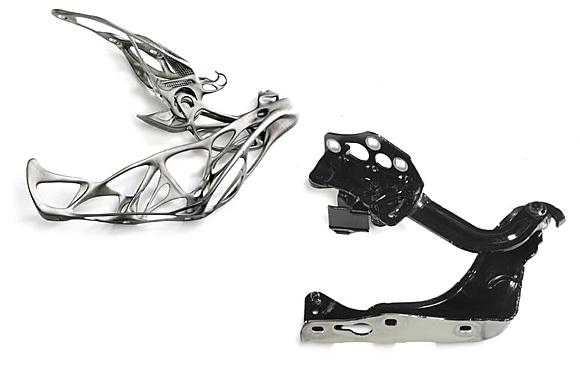Project LightHinge+ demonstrates practical potential of Additive Manufacturing
September 18, 2017

A comparison between the AM hinge (left) and traditional hinge (right)
Project LightHinge+, developed with the aim of producing an additively manufactured automotive hood hinge that combines lightweight construction and increased safety in a single construction, has successfully demonstrated the practical use and potential of Additive Manufacturing technologies in automotive production, the participants report. The project was a collaboration between EDAG Engineering GmbH, voestalpine Additive Manufacturing Center and Simufact Engineering GmbH.
“Engine hood hinge systems are very complex because of the high demands on safety and functionality,” stated Dr Martin Hillebrecht, Head of Competence Center Lightweight Construction, Materials and Technologies at EDAG Engineering GmbH. “This means that lightweight construction is still on the line. That is why, together with voestalpine and Simufact, we have set ourselves the goal of rethinking the hinge by means of generative production.”
In the first stage of development, EDAG engineers redesigned the hinge system for Additive Manufacturing. Next, the partners optimised the topology of the component structure to achieve the desired weight advantage. Using bionic principles, EDAG engineers were able to determine the minimum material requirements and achieve a 50% weight advantage over the reference hinge. The subsequent optimisation of the support structures was carried out in close cooperation with the voestalpine Additive Manufacturing Center.
“The topology optimisation calculates the minimal material requirements of the hinge,” explained Dr. Eric Klemp, Managing Director of the voestalpine Additive Manufacturing Center in Duesseldorf, Germany. “The resulting component’s geometries require a high proportion of support structures, which we could then minimise.”
An important step in the design and production of additive components is the simulation of the build process. Here, the project relied on Simufact Additive, a simulation software developed especially for additive production. “In the Additive Manufacturing process, the concentrated heat input with high heating and cooling rates causes distortion and residual stresses in the component,” stated Dr Patrick Mehmert, Product Manager Additive Manufacturing at Simufact. “A non-distortion-compensated hinge can thus deviate from one to two millimetres to the reference geometry respectively.”
With Simufact Additive, the partners were able to simulate the actual printing process and the subsequent process steps and thus predict distortions and residual stresses. “On the basis of simulated distortion, we have negatively deformed the component geometry so as to minimise the shape deviations of the printed hinges to the target geometry,” stated Mehmert.
At the conclusion of the project, the voestalpine Additive Manufacturing Center reported that it had achieved an economical, resource-saving production with low rework. “The LightHinge+ hood hinge fully exploits the potential of Additive Manufacturing by means of efficient software-assisted engineering,” Hillebrecht concludd. “An ultimate weight reduction and integration of a pedestrian protection function, in distortion and self-tension optimised tool-less production with little rework for small series is achieved.”
















